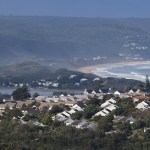LIGHTS OUT
Power was cut somewhere in SA in Q3 47.7% of the time — Reserve Bank

The South African Reserve Bank has been crunching the numbers on rolling blackouts, and while the picture that emerges is dim, light is also being shone on the issue. South Africa is becoming a leader in the science of calculating the impact of power shortages on GDP. This is not a good thing.
According to the SA Reserve Bank’s (Sarb) latest Quarterly Bulletin, the lights were out somewhere in South Africa almost half of the time during the third quarter (Q3) of 2022 — another epic record in ongoing state failure.
“Electricity load shedding in South Africa has been more frequent in recent years, increasing from 9.7% of the time (an average of three calendar days per month) in 2015 to 33.4% of the time (an average of 10.4 calendar days per month) in 2022 until the end of October,” the Quarterly Bulletin, published on Thursday, said.
“During the third quarter of 2022, load shedding reached an all-time high of 1,054 hours, or 47.7% of the time (an average of 14.8 calendar days per month).”
The Sarb has also fine-tuned its measurements for the impact of rolling blackouts — one of the few central banks in the world, one imagines, that is burdened with such an exercise.
“The previous intensity index measured load shedding incidences to gauge the effect of load shedding on total real gross domestic product growth as well as on real gross value added by subsector.
“The revised intensity index incorporates changes in both load shedding stages and duration during the day, while also providing for the differentiation of the impact in terms of the type of day; for example, weekdays, weekends and public holidays, as well as between the time of day with regard to conventional working and non-working hours (conventional hours are considered to be from 5am to 7pm),” it said.

The upshot is that the Sarb has derived three measures of rolling blackouts intensity, which surely indicates the seriousness of the issue.
The first measures the total GWh of power taken off the grid to prevent a complete collapse of the system. The second differentiates between outages imposed on workdays and those that occur on weekends and public holidays, with the latter allocated a half-weight. The third refines the second by excluding rolling blackouts that take place between “conventional working hours”.
“The number of load shedding hours often more than halved following the working-hour adjustment, implying that load shedding frequently occurred after conventional working hours.
“In the third quarter of 2022, there were 259 hours of stages 1 and 2 load shedding, but when adjusted for conventional working hours, this reduced to 94 hours,” the Sarb said.
Visit Daily Maverick’s home page for more news, analysis and investigations
Among other things, this suggests Eskom is indeed striving to turn off the lights when they are least needed, which may also help to explain why the economy grew a surprising 1.6% in Q3 despite the record levels of load shedding.
Still, the Quarterly Bulletin notes that the adjusted measurements show that “load shedding did have a statistically significant negative impact on total real GDP growth and on the subsectors”.
“From the analysis, the subsectors most affected by electricity load shedding were agriculture, forestry and fishing, manufacturing, mining and transport, storage and communication.”
“When adjusted for weekends, public holidays and non-conventional working hours, one additional GWh of load shedding was estimated to lower quarterly growth in real GDP by -0.0014 percentage points, on average.
“During the third quarter of 2022, the unadjusted load shedding intensity index was at a record high of 3,736 GWh, which implies that load shedding likely lowered quarterly real GDP growth by 2.1 percentage points.
“When considering weekends, public holidays and non-conventional working hours, the load shedding intensity index was at 1,692.5 GWh, implying a 2.3 percentage point reduction in quarterly real GDP growth for the third quarter.”
The Quarterly Bulletin does stress that “the results are merely indicative and should be interpreted as such. It does not take other information into account, such as changes in the demand for electricity due to energy self-sufficiency”. That would presumably include private households and companies installing solar panels on their roofs.
The bottom line is that South Africa’s power woes are curtailing the economy’s growth potential in ways that are both material and increasingly measurable. South Africa is becoming a leader in the science of calculating the impact of power shortages on GDP.
This, it should go without saying, is not a good thing. DM/BM


















 Become an Insider
Become an Insider
Comments - Please login in order to comment.